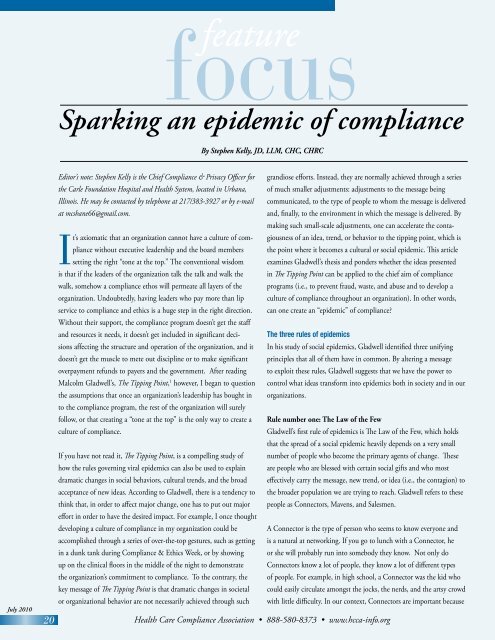Kimberly Johnson, RHIA, CPC, CHC - Health Care Compliance ...
Kimberly Johnson, RHIA, CPC, CHC - Health Care Compliance ...
Kimberly Johnson, RHIA, CPC, CHC - Health Care Compliance ...
You also want an ePaper? Increase the reach of your titles
YUMPU automatically turns print PDFs into web optimized ePapers that Google loves.
focus<br />
feature<br />
Sparking an epidemic of compliance<br />
By Stephen Kelly, JD, LLM, <strong>CHC</strong>, CHRC<br />
July 2010<br />
20<br />
Editor’s note: Stephen Kelly is the Chief <strong>Compliance</strong> & Privacy Officer for<br />
the Carle Foundation Hospital and <strong>Health</strong> System, located in Urbana,<br />
Illinois. He may be contacted by telephone at 217/383-3927 or by e-mail<br />
at mcshane66@gmail.com.<br />
It’s axiomatic that an organization cannot have a culture of compliance<br />
without executive leadership and the board members<br />
setting the right “tone at the top.” The conventional wisdom<br />
is that if the leaders of the organization talk the talk and walk the<br />
walk, somehow a compliance ethos will permeate all layers of the<br />
organization. Undoubtedly, having leaders who pay more than lip<br />
service to compliance and ethics is a huge step in the right direction.<br />
Without their support, the compliance program doesn’t get the staff<br />
and resources it needs, it doesn’t get included in significant decisions<br />
affecting the structure and operation of the organization, and it<br />
doesn’t get the muscle to mete out discipline or to make significant<br />
overpayment refunds to payers and the government. After reading<br />
Malcolm Gladwell’s, The Tipping Point, 1 however, I began to question<br />
the assumptions that once an organization’s leadership has bought in<br />
to the compliance program, the rest of the organization will surely<br />
follow, or that creating a “tone at the top” is the only way to create a<br />
culture of compliance.<br />
If you have not read it, The Tipping Point, is a compelling study of<br />
how the rules governing viral epidemics can also be used to explain<br />
dramatic changes in social behaviors, cultural trends, and the broad<br />
acceptance of new ideas. According to Gladwell, there is a tendency to<br />
think that, in order to affect major change, one has to put out major<br />
effort in order to have the desired impact. For example, I once thought<br />
developing a culture of compliance in my organization could be<br />
accomplished through a series of over-the-top gestures, such as getting<br />
in a dunk tank during <strong>Compliance</strong> & Ethics Week, or by showing<br />
up on the clinical floors in the middle of the night to demonstrate<br />
the organization’s commitment to compliance. To the contrary, the<br />
key message of The Tipping Point is that dramatic changes in societal<br />
or organizational behavior are not necessarily achieved through such<br />
grandiose efforts. Instead, they are normally achieved through a series<br />
of much smaller adjustments: adjustments to the message being<br />
communicated, to the type of people to whom the message is delivered<br />
and, finally, to the environment in which the message is delivered. By<br />
making such small-scale adjustments, one can accelerate the contagiousness<br />
of an idea, trend, or behavior to the tipping point, which is<br />
the point where it becomes a cultural or social epidemic. This article<br />
examines Gladwell’s thesis and ponders whether the ideas presented<br />
in The Tipping Point can be applied to the chief aim of compliance<br />
programs (i.e., to prevent fraud, waste, and abuse and to develop a<br />
culture of compliance throughout an organization). In other words,<br />
can one create an “epidemic” of compliance?<br />
The three rules of epidemics<br />
In his study of social epidemics, Gladwell identified three unifying<br />
principles that all of them have in common. By altering a message<br />
to exploit these rules, Gladwell suggests that we have the power to<br />
control what ideas transform into epidemics both in society and in our<br />
organizations.<br />
Rule number one: The Law of the Few<br />
Gladwell’s first rule of epidemics is The Law of the Few, which holds<br />
that the spread of a social epidemic heavily depends on a very small<br />
number of people who become the primary agents of change. These<br />
are people who are blessed with certain social gifts and who most<br />
effectively carry the message, new trend, or idea (i.e., the contagion) to<br />
the broader population we are trying to reach. Gladwell refers to these<br />
people as Connectors, Mavens, and Salesmen.<br />
A Connector is the type of person who seems to know everyone and<br />
is a natural at networking. If you go to lunch with a Connector, he<br />
or she will probably run into somebody they know. Not only do<br />
Connectors know a lot of people, they know a lot of different types<br />
of people. For example, in high school, a Connector was the kid who<br />
could easily circulate amongst the jocks, the nerds, and the artsy crowd<br />
with little difficulty. In our context, Connectors are important because<br />
<strong>Health</strong> <strong>Care</strong> <strong>Compliance</strong> Association • 888-580-8373 • www.hcca-info.org

















